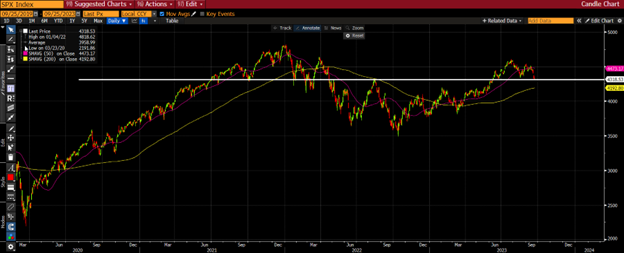Fed to Wall Street: wake up — Week of September 25, 2023

| index | wtd | ytd | 1-year | 3-year | 5-year | index level |
|---|---|---|---|---|---|---|
| S&P 500 Index | -2.91 | 13.87 | 16.89 | 10.93 | 9.93 | 4,320.06 |
| Dow Jones Industrial Average | -1.89 | 4.13 | 15.38 | 9.76 | 7.19 | 33,963.84 |
| Russell 2000 Small Cap | -3.81 | 1.95 | 4.73 | 7.20 | 2.07 | 1,776.50 |
| NASDAQ Composite | -3.61 | 27.03 | 20.46 | 7.28 | 11.60 | 13,211.81 |
| MSCI Europe, Australasia & Far East | -2.03 | 9.19 | 23.17 | 7.04 | 3.96 | 2,064.71 |
| MSCI Emerging Markets | -2.08 | 3.27 | 7.70 | -1.02 | 1.07 | 964.24 |
| Barclays U.S. Aggregate Bond Index | -0.87 | -0.61 | 0.00 | -5.08 | 0.26 | 2,036.24 |
| Merrill Lynch Intermediate Municipal | -0.77 | 0.06 | 2.62 | -1.48 | 1.53 | 299.00 |
As of market close September 22, 2023. Returns in percent.
Investment Insights
— Steve Orr
Get me
To October, please. I’ll even buy you a pumpkin spice something. We have droned ad nauseum about the fall being choppy and getting a correction. NASDAQ and the S&P 500 are both more than 5% below their August high. Only 40% of the S&P and 30% of the NASDAQ are trading above their 200-day moving average. You read that right, 70% of the NASDAQ is trading below its trailing one-year average. True, during the spring’s bank deposit crisis, the level dropped briefly to the 10% range. For most of the last two years, the 30% level has been an area where the index would bounce higher in price. So, here’s your correction.
Technically, Friday’s levels would be a good place to bounce higher, or at least stop dropping. Running back two years on the chart, 4,350 has served as resistance and, at least until Friday, strong support (white horizontal line).

Source: Bloomberg, L.P., Standard & Poor's
We are on track for a weak September. If we close the books as of Friday, the S&P 500 would be down -4%, for its worst loss of the year. What happens when both August and September are down more than 1%? Well, during the times of “easy money” and low interest rates of 2011 and 2015, the big index popped over 8% in October. In the same setup last year, with higher interest rates, the S&P 500 climbed a quick 8.1% in the last two weeks of October.
That jump was on the back of good third-quarter earnings reports. In our minds, a jump higher in October would be the result of better-than-expected earnings, especially from the banks. This week may provide a look at the health of the consumer. Costco, the big warehouse retailer, reports on Tuesday and may give us an idea of Christmas activity. On Thursday, CarMax and Nike will give us a reading on discretionary purchases. Consumer Discretionary is a bit of a catchall sector, with autos, Amazon, restaurants and retail. The only catching it’s done recently is “new lows” disease, dropping in relative strength week over week to the broader S&P 500. Some of the drop is due to higher gas prices crimping auto sales, and consumers cutting back. Third-quarter earnings season kicks off, appropriately (spookily?), on Friday the 13th with the big banks.
Fundamentals continue to build a wall of worry. The four wars1, inflation around 4%, higher interest rates and higher fuel costs all contribute to negative sentiment and worries around earnings. We covered higher fuel prices a couple of weeks back. The Administration does not have the Strategic Petroleum Reserve to draw on. If much more crude is drawn out, the domes will fill with salt brine, and it will be prohibitively expensive to repair them for crude storage. The war situation is, at best, a stalemate in many places. Wall Street is finally coming around to the idea that higher rates are here for longer (than Wall Street wants). We would add that longer rates are headed higher.
Driving home
The two big news points for this month will be the Fed’s meeting last week and the deficit. The deficit blew through $1.5 trillion earlier this month, as Congress continues to play drunken sailor. The borrowing binge means bond investors are losing patience with the waves of supply of Treasury securities. At this writing, Congress is not close to passing the 12 appropriations bills needed to pass a budget. Cue the government shutdown and deals in Congress to continue spending.
Bond Bulls contend, correctly, that real yields (rates minus CPI inflation) are relatively cheap and that investors should start buying with the Treasury 10-year at 4.5%. We agree that the 10-year real rate, currently about 0.4%, is relatively cheap. But that analysis only looks at the extreme negative yields that accompanied zero percent short rates that were held down by the Fed after shutdown. Real yields averaged 3.5% in the 1990s and 1.9% in the 2000s. Oh, what about the “Quantitative Easing Era” of Central Bank control in the 2010s? Try 0.43% or right where we are today. Real rates have quite a ways to rise to get back to the old “normal.”
Abby Normal
The early 2010s marked a return to World War II-era control of U.S. Treasury yields. The Fed and Treasury worked together, along with central banks of other G20 countries, to artificially suppress interest rates. We began thinking the interest rate cycle was ending in 2016. We were both wrong and early, as the Treasury 10-year ran from 1.5% to 3.15% by early 2018. The entire decade was a parade of abnormally low interest rates. Please note, dear reader, that our interest rates move in roughly 40-year cycles. The Bull market in lower interest rates (and higher bond prices) likely ended in the shutdown of March 2020 when the 10-year touched an all-time low of 0.31%. We are several years into the new 40-year Bear cycle of higher interest rates and weaker bond prices. Does this mean we are going back to the teens yields of the early 1980s? No, not at all. Is an 8% mortgage rate possible in the coming year or so? Yes, it’s possible.
Today’s 4.5% is truly a far cry from that level, but let’s place it in context. At 4.5%, you are locking up your principal in a U.S. Treasury Note for 10 years. Over that horizon, what will inflation average? At least 3%? Then you are earning 1.5% real yield, or back to the 2000s. Depending on your choice of starting decade in the 1700s, for the last 200-plus years the 10-year has averaged close to 4.5%. Hopefully, abnormally low yields are now history.
Yes, higher
The Fed left its overnight Fed Fund’s target range unchanged at last week’s meeting. The press release noted the economy was a notch stronger, changing the wording from “moderate pace” to “solid pace.” A couple of items grabbed traders’ attention and sent bond rates back toward that 4.5% level. First, the quarterly projections of future short-term rates showed an increase of one-half of a percent next year. In other words, Committee members think that rates are going to stay close to the current levels for most of next year, rather than rates dropping a half of a percent at some point. If that was not jarring enough, Chairman Powell reaffirmed the Fed’s commitment to fight inflation during his press conference. Two statements stand out. The first is about fighting inflation: “The real point, though, is the worst thing we can do is fail to restore price stability, because the record is clear on that. If you don’t restore price stability, inflation comes back. People hate inflation. Hate it.” Restoring price stability is economist talk for beating down inflation.
The second statement that caught our ear was when asked if a soft landing for the economy was a baseline expectation; he replied that it was not. He reiterated that price stability was job #1 and that changes in unemployment may happen later. Give Powell credit, he has repeated these themes for almost two years; Wall Street may be starting to listen. If they haven’t been, Fed Governor Bowman and Boston Fed President Collins both said on Friday that they support rates being at this level and are open to further increases to fight inflation.
Wrap-Up
September is living “down” to history, being the worst performance month of the year for stocks. Watching volatility and options activity, we wonder how much shutdown odds are already priced into stocks and, to an extent, bond yields.
Inflation reports from a number of countries this week will show it is becoming a part of the landscape and that investment policies and plans must be adjusted. We are using the correction for opportunities in stocks but remain wary of higher rates.
1Four wars: space, cyber, Ukraine, now Africa
Steve Orr is the Managing Director and Chief Investment Officer for Texas Capital Bank Private Wealth Advisors. Steve has earned the right to use the Chartered Financial Analyst and Chartered Market Technician designations. He holds a Bachelor of Arts in Economics from The University of Texas at Austin, a Master of Business Administration in Finance from Texas State University, and a Juris Doctor in Securities from St. Mary’s University School of Law. Follow him on Twitter here.
The contents of this article are subject to the terms and conditions available here.